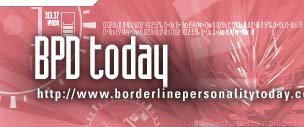 |
|
 |
|
|
|
||||
|
| Borderline Personality Today | ||||
|
ICD-10Criteria for Borderline Personality DisorderThe ICD-10 Classification of Mental and Behavioural Disorders World Health Organization, Geneva, 1992F60.3 Emotionally Unstable (Borderline) Personality DisorderA personality disorder in which there is a marked tendency to act impulsively without consideration of the consequences, together with affective instability. The ability to plan ahead may be minimal, and outbursts of intense anger may often lead to violence or "behavioural explosions"; these are easily precipitated when impulsive acts are criticized or thwarted by others. Two variants of this personality disorder are specified, and both share this general theme of impulsiveness and lack of self-control.
Impulsive type:
Borderline type: Personality DisordersA personality disorder is a severe disturbance in the characterological constitution and behavioural tendencies of the individual, usually involving several areas of the personality, and nearly always associated with considerable personal and social disruption. Personality disorder tends to appear in late childhood or adolescence and continues to be manifest into adulthood. It is therefore unlikely that the diagnosis of personality disorder will be appropriate before the age of 16 or 17 years. General diagnostic guidelines applying to all personality disorders are presented below; supplementary descriptions are provided with each of the subtypes. Diagnostic Guidelines
Conditions not directly attributable to gross brain damage or disease,
or to another psychiatric disorder, meeting the following criteria: Does the ICD 10 classification accurately describe subtypes of borderline personality disorder?Br J Med Psychol. 2000 Dec;73 Pt 4:483-94.Whewell P, Ryman A, Bonanno D, Heather N. Newcastle City Health NHS Trust, Regional Department of Psychotherapy, Newcastle upon Tyne, UK. "The aim of the paper is to explore whether the division of borderline personality disorder, as described in the DSM classification, into impulsive and borderline subtypes of emotionally unstable personality disorder in the ICD classification of personality disorder, is a valid division. The self-report questionnaire responses of 288 referrals to a personality disorder service were rated on each of the eight criteria for DSM-III-R diagnosis of borderline personality disorder. Factor analysis identified two factors; factor one closely corresponds with the borderline subtype of ICD10, whilst factor two closely corresponds with the impulsive subtype of ICD10. Criteria common to both factors unstable relationships and identity confusion - were considered core features of borderline personality disorder. The pattern of occurrence of the two factors was similar to the complex binary picture described by ICD10. However there were also differences. Firstly, identity confusion is found to be a core feature of both our factors, and this does not conform to the restriction of identity confusion to the borderline subtypes in ICD10. Secondly, we found a residual pool of undifferentiated borderline patients and a small group of pure non-impulsive borderline patients who are not currently accommodated within the ICD10 emotionally unstable personality disorder. We conclude that future classifications of this disorder should accommodate four subtypes, and suggest these subtypes have implications for treatment and further research." PubMed ICD-10 copyright � 1992 by World Health
Organization. Visit Mental Health Matters for information and articles. Get help to find a therapist or list your practice; and Psych Forums for message boards on a variety of MH topics. Sponsors: Aphrodite's Love Poetry ¦ Make Money on the Internet
Copyright © 2002 - 2003 Patty Pheil, M.S.W. All rights reserved. |
|